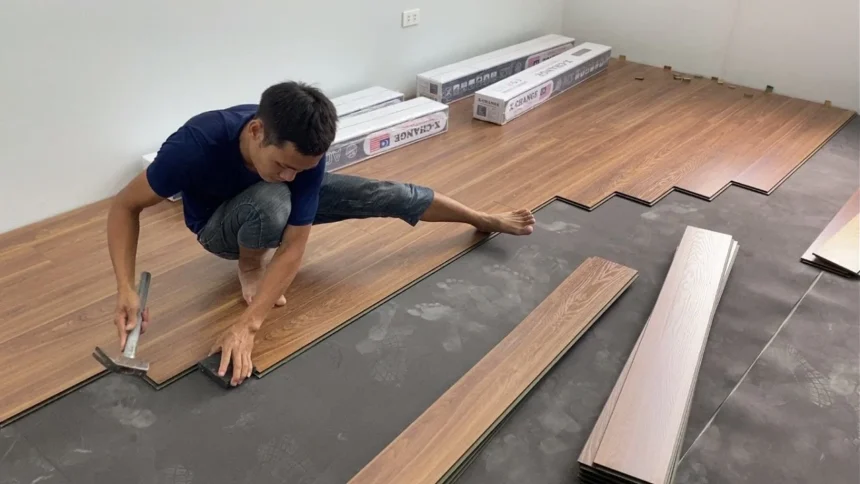Introduction:
The flooring of a space is a foundational element that significantly influences its aesthetics, functionality, and overall atmosphere. Choosing the right flooring technique is crucial for creating a harmonious and visually appealing environment. In this comprehensive guide, we will explore various flooring techniques, materials, and styles, empowering you to make informed decisions that align with your design preferences and practical needs.
Flooring Materials
Hardwood Flooring:
Timeless and elegant, hardwood flooring is a popular choice that adds warmth and character to any space. With options such as oak, maple, and walnut, hardwood floors are durable, long-lasting, and can be refinished to maintain their beauty over time.
Laminate Flooring:
Laminate flooring offers a cost-effective alternative to hardwood, mimicking its appearance while being more resistant to scratches and moisture. This versatile material is available in various styles, including wood, stone, and tile patterns.
Engineered Wood Flooring:
Engineered wood flooring combines the aesthetics of hardwood with enhanced durability. Constructed from layers of wood and topped with a real wood veneer, it is more resistant to moisture and temperature fluctuations, making it suitable for a wider range of environments.
Vinyl Flooring:
Vinyl flooring is known for its affordability, versatility, and easy maintenance. It comes in a variety of styles, including sheets, tiles, and planks, and can replicate the appearance of hardwood, tile, or stone.
Ceramic and Porcelain Tiles:
Tiles are durable, water-resistant, and available in an extensive range of colors, patterns, and textures. Ceramic tiles are suitable for indoor use, while porcelain tiles, being denser and more durable, are suitable for both indoor and outdoor applications.
Natural Stone Flooring:
Timeless and luxurious, natural stone flooring options like marble, granite, and travertine add sophistication to any space. While more expensive, these materials bring a unique, natural beauty to floors.
Flooring Techniques
Straight Lay:
The straight lay technique is the most common and straightforward method of installing flooring. Whether it’s hardwood planks, tiles, or laminates, the materials are laid parallel or perpendicular to the walls, creating a classic and timeless look.
Diagonal Lay:
For an added touch of visual interest, the diagonal lay technique involves installing flooring materials at a 45-degree angle to the walls. This technique works well with both square and rectangular tiles, creating a dynamic and eye-catching pattern.
Herringbone Pattern:
The herringbone pattern is a classic choice that involves laying rectangular tiles or hardwood planks at a 90-degree angle to form a distinctive V-shaped pattern. This technique adds a sense of elegance and sophistication to the flooring.
Chevron Pattern:
Similar to the herringbone pattern, the chevron pattern features tiles or planks arranged in a V-shaped design. However, in the chevron pattern, the ends are cut at an angle to create a seamless zigzag effect.
Basketweave Pattern:
The basketweave pattern involves combining square and rectangular tiles to create a woven, interlocking design. This technique adds a touch of texture and visual interest to the flooring, making it a popular choice for bathrooms and kitchens.
Inlays and Borders
Medallions and Insets:
Inlays, medallions, and insets involve incorporating intricate designs or patterns within the flooring. These decorative elements can be made from contrasting materials, creating a focal point and adding artistic flair to the space.
Border Accents:
Borders provide a defined edge to the flooring, creating a visual frame. They can be simple or elaborate, depending on the desired aesthetic. Borders are often used to delineate different areas within a room or to add a touch of elegance to larger spaces.
Flooring for Specific Spaces
Kitchen Flooring:
Given the high traffic and potential for spills in kitchens, durable and easy-to-clean flooring materials like ceramic tiles, vinyl, or laminate are ideal choices. Consider patterns that mask dirt and stains, and ensure the material can withstand the demands of a busy kitchen.
Bathroom Flooring:
Bathrooms require flooring that is resistant to moisture. Ceramic and porcelain tiles, vinyl, and natural stone are suitable options. Consider slip-resistant finishes for safety, and explore creative patterns to enhance the visual appeal of the space.
Living Room and Bedrooms:
For these more relaxed and comfort-oriented spaces, hardwood, carpet, or engineered wood flooring can create a cozy atmosphere. Area rugs and carpets add warmth, while hardwood or laminate floors offer timeless elegance.
Outdoor Flooring:
Choosing the right flooring for outdoor spaces is essential to withstand weather conditions. Options like concrete, porcelain tiles, or natural stone are durable and resistant to the elements, providing a stylish extension of indoor living spaces.
Flooring Maintenance and Care
Regular Cleaning:
Maintaining the beauty of your flooring starts with regular cleaning. Different materials require specific cleaning methods, so follow manufacturer recommendations to prevent damage.
Area Rugs and Mats:
Placing area rugs or mats in high-traffic areas helps protect the flooring from wear and tear. They also add a layer of comfort and can be easily replaced or cleaned.
Furniture Pads:
To prevent scratches and dents caused by furniture, use furniture pads on chairs and table legs. This simple precaution can significantly extend the life of your flooring.
Professional Maintenance:
Consider professional maintenance, such as refinishing for hardwood floors or sealing for natural stone, to keep your flooring in optimal condition. Professional services can enhance durability and refresh the appearance of your floors.
Conclusion:
Selecting the right flooring technique is a pivotal aspect of interior design, influencing the overall ambiance, functionality, and aesthetics of a space. By understanding different flooring materials, techniques, and styles, you can make informed decisions that align with your preferences and practical needs. Whether you prefer classic hardwood, modern tiles, or versatile laminates, mastering the art of flooring allows you to create a space that reflects your unique style and stands the test of time.







